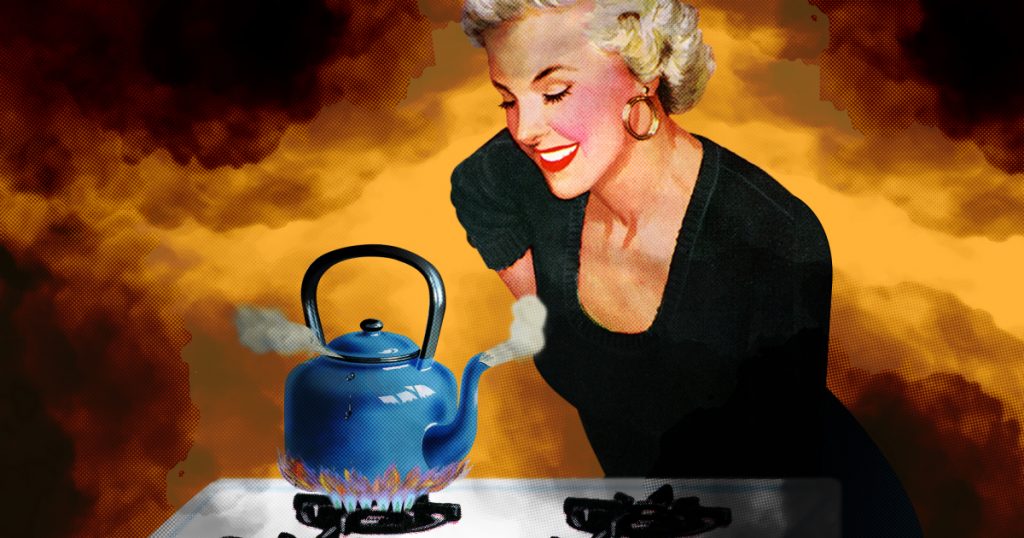How the Fossil Fuel Industry Convinced Americans to Love Gas Stoves
Let our journalists help you make sense of the noise: Subscribe to the Mother Jones Daily newsletter and get a recap of news that matters.Early last year in the Fox Hills neighborhood of Culver City, California, a man named Wilson Truong posted an item on the Nextdoor social media platform—where users can interact with their neighbors—warning that city leaders were considering stronger building codes that would discourage the use of natural gas in new homes and businesses. In a message titled “Culver City banning gas stoves?” he wrote, “First time I heard about it I thought it was bogus, but I received a newsletter from the city about public hearings to discuss it…Will it pass???!!! I used an electric stove but it never cooked as well as a gas stove so I ended up switching back.”
Truong’s post ignited a debate. One neighbor, Chris, defended electric induction stoves. “Easy to clean,” he wrote of these glass stovetops, which use a magnetic field to heat pans. Another neighbor, Laura, expressed skepticism. “No way,” she wrote. “I am staying with gas. I hope you can too.”
Unbeknownst to both, Truong wasn’t their neighbor at all, but an account manager for Imprenta Communications Group. Among the public relations firm’s clients was Californians for Balanced Energy Solutions, a front for the nation’s largest gas utility, SoCalGas, which aims to thwart state and local initiatives restricting the use of fossil fuels in new buildings. c4bes had tasked Imprenta with exploring how platforms such as Nextdoor could be used to engineer community support for natural gas. Imprenta assured me that Truong’s post was an isolated affair, but c4bes displays it alongside two other anonymous Nextdoor comments on its website as evidence of its advocacy in action.
Microtargeting Nextdoor groups is part of the newest front in the gas industry’s war to bolster public support for its product. For decades the American public was largely sold on the notion that “natural” gas was relatively clean, and when used in the kitchen, even classy. But that was before climate change moved from distant worry to proximate danger. Burning natural gas in commercial and residential buildings accounts for more than 10 percent of US emissions, so moving toward homes and apartments powered by wind and solar electricity instead could make a real dent. Gas stoves and ovens also produce far worse indoor air pollution than most people realize; running a gas stove and oven for just an hour can produce unsafe pollutant levels throughout your house all day. These concerns have prompted moves by 42 municipalities to phase out gas in new buildings. Washington state lawmakers intend to end all use of natural gas by 2050. California has passed aggressive standards, including a plan to reduce commercial and residential emissions to 60 percent of 1990 levels by 2030. During his campaign, President Biden called for stricter standards for appliances and new construction. Were more stringent federal rules to come to pass, it could motivate builders to ditch gas hookups for good.
Gas utilities have responded to this existential threat to their livelihood by launching local anti-electrification campaigns. To ward off a municipal vote in San Luis Obispo, California, a union representing gas utility workers threatened to bus in “hundreds” of protesters during the pandemic with “no social distancing in place.” In Santa Barbara, residents have received robotexts warning that a gas ban would dramatically increase their bills. The Pacific Northwest group Partnership for Energy Progress, funded in part by Washington state’s largest gas utility, Puget Sound Energy, has spent at least $1 million opposing electrification mandates in Bellingham and Seattle, including $91,000 on bus ads showing a happy family cooking with gas next to the slogan “Reliable. Affordable. Natural Gas. Here for You.”
The industry group American Gas Association has a website dedicated to promoting cooking with gas.
The gas industry also has worked aggressively with legislatures in seven states to enact laws—at least 14 more have bills—that would prevent cities from passing cleaner building codes. This past spring, according to a HuffPost investigation, gas and construction interests managed to block cities from pushing for the stricter energy efficiency codes favored by local officials. In a potential blow to the Biden administration’s climate ambitions, two big trade groups convinced the International Code Council—the notoriously industry-friendly gatekeeper of default construction codes—to cut local officials out of the decision-making process entirely.
Beyond applying political pressure, the gas industry has identified a clever way to capture the public imagination. Surveys showed that most people had no preference for gas water heaters and furnaces over electric ones. So the gas companies found a different appliance to focus on. For decades, sleek industry campaigns have portrayed gas stoves—like granite countertops, farm sinks, and stainless-steel refrigerators—as a coveted symbol of class and sophistication, not to mention a selling point for builders and real estate agents.
The strategy has been remarkably successful in boosting sales of natural gas, but as the tides turn against fossil fuels, defending gas stoves has become a rear guard action. While stoves were once crucial to expanding the industry’s empire, now they are a last-ditch attempt to defend its shrinking borders.
Over the last hundred years, gas companies have engaged an all-out campaign to convince Americans that cooking with a gas flame is superior to using electric heat. At the same time, they’ve urged us not to think too hard—if at all—about what it means to combust a fossil fuel in our homes.
In the 1930s, the industry embraced the term “natural gas,” which gave the impression that its product was cleaner than any other fossil fuel: “The discovery of Natural Gas brought to man the greater and most efficient heating fuel which the world has ever known,” bragged one 1934 ad. “Justly is it called—nature’s perfect fuel.”
It was also during the 1930s that the industry first adopted the slogan “cooking with gas”; a gas executive saw to it that the phrase worked its way into Bob Hope bits and Disney cartoons. By the 1950s the industry was targeting housewives with star-studded commercials that featured matinee idols scheming about how to get their husbands to renovate their kitchens. In one 1964 newspaper advertisement from the Pennsylvania People’s Natural Gas Company, the star Marlene Dietrich professed, “Every recipe I give is closely related to cooking with gas. If forced, I can cook on an electric stove but it is not a happy union.” (Around the same time, General Electric waged an advertising campaign starring Ronald Reagan that depicted an all-electric house as a Jetsons-like future.) During the 1980s, the gas industry debuted a cringeworthy rap: “I cook with gas cause the cost is much less / Than ’lectricity. Do you want to take a guess?” and “I cook with gas cause broiling’s so clean / The flame consumes the smoke and grease.”





